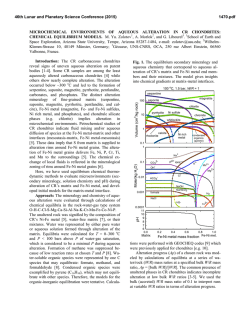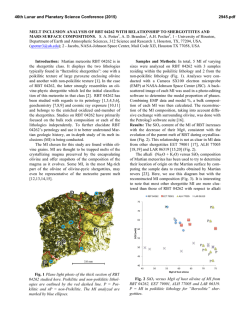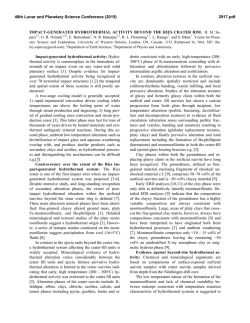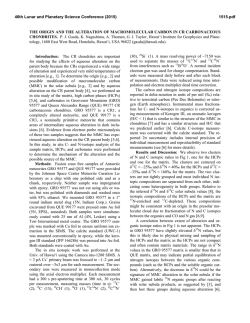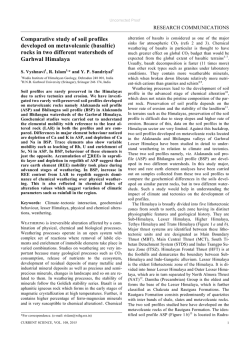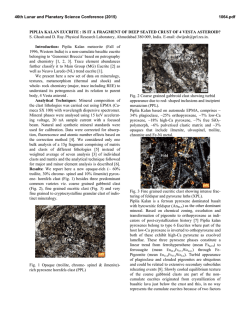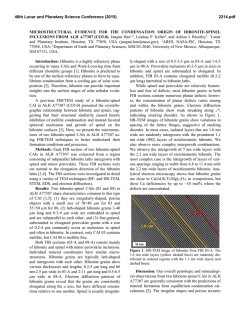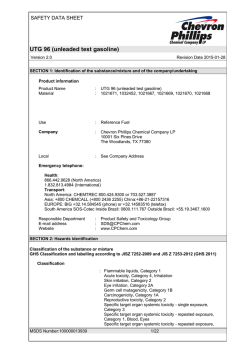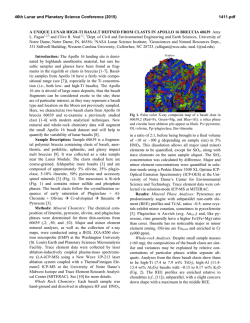
TRACE ELEMENT MOBILITY IN COLD DESERT ALTERATION
46th Lunar and Planetary Science Conference (2015) 1820.pdf TRACE ELEMENT MOBILITY IN COLD DESERT ALTERATION SYSTEMS. E. D. Steer1 , S. P. Schwenzer1, I. P. Wright1, M. M. Grady1, 1Department of Physical Sciences, The Open University, Walton Hall, Milton Keynes, United Kingdom, MK7 6AA. ([email protected]) Introduction: Alteration of rocks is a fundamental process that occurs in all environments across the solar system in different forms. Understanding the patterns of alteration, the formation of different products, the liberation of certain elements from minerals can inform us about environments billions of years old [e.g. 1, 2, 3]. They can give us information about quantities of water, temperatures, atmospheres and biology. This study focuses on cold desert environments and the geochemical fingerprints processes leave in some of the most abundant minerals in the solar system. Specifically, this study looks at how trace elements move in cold weathering systems, using Antarctic ordinary chondrites as an analogue, and how weathering features of cold environments combine with little water to interact with rocks. Samples: Four L6 chondrites collected from Antarctica were used in the study: QUE 94214, QUE 99022, ALH 78130 and ALH 85017. The meteorites used cover the range of weathering and fracture grades A-C (A being least, C being most) as set out in the Antarctic Newsletter [4]. Thin and thick sections of the rims and interiors of QUE 94214 and ALH 78130, rim sections from ALH 85017 and interior sections of QUE 99022 were used for petrological studies. All rim sections contain fusion crust. Methods: Reflectance and transmitted light microscopy was performed to get an overview of the sample texturally and mineralogically. A FEI Quanta 3D dual beam scanning electron microscope fitted with an Oxford Instruments 80 mm X-MAX energy dispersive X-ray detector was used at The Open University to obtain images and element maps. From these, modal counts of mineral types were obtained. Also quantified were the amounts of Fe-Ni metals and sulphides converted to alteration products, as well as a general % of sample covered with rust, using the imaging software package imageJ. Trace element analysis was carried out using LA-ICP-MS on an Agilent 7500 s quadrupole mass spectrometer coupled to a New Wave 213 nm Nd–YAG laser system using a 60 μm spot size. Petrology: The most obvious evidence of alteration in meteorites is macroscopically visible red rust. As such, it is used as the basis for most weathering grades [4, 5]. The rust originates from the hydration and oxidation of taenite, kamacite and troilite. These minerals are the most readily weathered in the sample. As they weather, they form haloes of Fe-oxyhydroxides around the particles which can then to some extent protect the metal grains from rapid alteration [6]. This means that the alteration is not a constant process but slows down with time [6]. The Fe-oxyhydroxides spread from the weathering grains, following open fluid pathways. These largely consist of transmineral fractures and intramineral fractures, created and extenuated by diurnal heating and cooling of the samples [7]. Rust can also be seen radiating from shock veins in QUE 99022 and ALH 78130 because these consist of many sub μm spherules of Fe-Ni metal, which are extremely vulnerable to weathering due to their comparative high surface area to volume ratios. These melt veins thus become more porous which allows easy access to fluids. This means adjacent silicate minerals have greater exposure to the fluids and are preferentially altered, with etching and pitting in olivines and lamellae etching in pyroxenes. The brittle nature of olivine and its pre-existing planar fractures (created by shock processes [8]) causes this mineral to often host a disproportionate amount of veins compared to plagioclase and pyroxene. ALH 85017 is the least altered of the samples, with rust covering 46 % of the rim sample, and 38 % of the interior sample (Table 1). QUE 99022 is the most weathered sample which is mostly due to the large melt veins that cross cut the samples and created a raised porosity and permeability. Trace elements: Co vs Ni in pyroxenes (Fig. 1) and olivines allows us to trace the breakdown of Fe-Ni metals and examine the extent to which they are disseminated. The more weathered samples (ALH 78130, QUE 99022) have higher Co and Ni abundances in pyroxenes than the less weathered meteorites (ALH 85017, QUE 94214). The least weathered, ALH 85017, has abundances of Ni 300 - 4700 ppm and Co up to 125 ppm in the pyroxenes. It also has a lower Co:Ni ratio compared to the other meteorites. The highest values of Co and Ni are in the most weathered meteorites, with up to: Co - 300 ppm, Ni - 6000 ppm. Mn values are indigenous to the pyroxenes and olivines, and trace the dissolution of the silicates. Mn abundances separate out the three more weathered meteorites from the less weathered ALH 85017 with higher values in the less weathered meteorite and a larger spread of values for the most weathered meteorite (QUE 99022) with comparative values 3300 - 3800 ppm in ALH 85017, and between 3000 - 4000 ppm in QUE 99022, and 3000 - 3500 ppm in ALH 78130. Silicate minerals were also separated into two groups: 46th Lunar and Planetary Science Conference (2015) silicates in visibly rusted areas and in visibly unaltered areas. The Co:Ni ratios of the rusted areas were shown to be much more varied with a greater tendency to have high values. However, Mn values of pyroxenes in rusted areas plot in the same region as those outside of visible alteration. Discussion: Co and Ni indigenous abundances in ordinary chondrite pyroxene are less than 50 ppm [9] and so a significant amount has been added to the more weathered samples. The main host of Co in ordinary chondrites is taenite and kamacite with between 6000 8000 ppm [10]. The combination of this with the pyroxenes in areas of rust having raised Co demonstrates a redistribution of trace elements from the weathering metals. That this increase follows areas of staining suggests that this contribution is coming from the deposition of alteration products in the fractures and imperfections in the crystal rather than a structural change in the pyroxene. As Co and Ni both occupy the octohedral site in pyroxene, a decrease in Fe and/or Mg would be expected with ionic exchange in the structure which is not observed in these samples as Fe is seen to increase in these areas [11]. Olivines show the same patterns, confirming that the re-distribution of elements is independent of the silicate mineralogy. Mn is different from Co and Ni in that it decreases in more weathered samples, indicating its removal from pyroxene and olivine by altering fluids. As Mn sits in the octahedral site of pyroxene with Fe and Mg, it may be accompanied by a decrease in both. However, this is not observed as any potential pattern is masked by the addition of Fe and Mg to the areas as nanophase Feoxyhydroxides. The broadening Mn values in QUE 99022 reflect patterns of basalt weathering observed by [12]. Mn is unlikely to be removed from the system entirely due to its low mobility [9], but is more likely to be oxidized and heterogeneously deposited around the sample, creating the broadening pattern of Mn concentrations as the oxidized Mn is deposited in alteration products. However, the lack of correlation between the Mn values of the pyroxenes and areas of rusting demonstrates this effect is not accounted for using purely a rust based weathering classification system. Conclusions: The mobilisation of trace elements from metals across entire samples creates positive Ni and Co anomalies where deposition of alteration products is occurring. This redistribution requires fluid transport to affect such large areas. The ability for the trace elements to spread over large areas is aided by open fractures and by porous structures of the altered melt veins. The Mn anomalies, however, are created by removal from the silicates. The breakdown of sulphide minerals creates acidic environments, because sulphuric acid is produced. This 1820.pdf acid attacks silicates and speeds up dissolution and removal of silicates [13]. This also speeds up the movement of trace elements indigenous to the silicates, such as the Mn anomaly that is seen. This is likely to occur in any acidic environments such as those at volcanic provenances as have been observed on Earth and Mars [13, 14]. These environments have been observed by the Opportunity rover at Meridiani Planum where the breakdown of olivine basalts has been carried out by acidic waters, resulting in the formation of hematite concretions [15]. References: [1] Vaniman, D. T. et al. (2013) Science, 343, 6169. [2] Velbel, M. A. et al. (2015) Geochimica, 148, pp402-425. [3] Cartwright, J. A. et al. (2013) Geochimica, 105, pp255-293. [4] The Meteoritical Bulletin, Accessed 20/11/14. [5] Wlotzka, F. (1993) Meteoritics, 28, pp460.[6] Lee M. R. et al. (2006) MAPS, 41, pp 1123-1138. [7] Andre M-F. et al. (2011) Polar Geography, 28, pp 43-63. [8] Stöffler, D. et al (1991) Geochimica et Cosmochimica Acta, 55. 3845-3867. [9] Wedepohl, K. H. et al. (1969). Handbook of Geochemistry. Springer-Verlag. [10] Rambaldi E. (1976) EPSL, 31, pp 224-238. [11] Steer, E. D. et al. (2014) LPSC # 1958. [12] Yaalon, D. H. (1972) Geoderma, 7. P 71. [13] Burns R. G. (1993), Geochimica, 57, pp 4555-4574. [14] Aiuppa, A. et al (2000). Geochimica, 64, pp 1827-1841. [15] Squyres, S. W and Knoll, H. K. (2005) EPSL, 1, pp 1-10. Sample Rust Coverage (%) Kamacite Altered (%) Taenite Altered (%) Troilite Altered (%) ALH 85017 R: 46 I: 38 R: 27 I: 17 R: 10 I: 9 R: 3 I: 4 ALH 78130 R: 66 I:100 R: 32 I: 73 R: 14 I: 60 R: 14 I: 20 QUE 99022 R: 100 I: 100 R: 69 I: 27 R: 60 I: 18 R: 20 I: 14 QUE 94214 R: 80 I: 52 R: 15 I: 15 R: 13 I: 9 R: 6 I: 14 Table 1 –Alteration summary of the four samples studied. All data taken from thin and thick sections using optical microscopy and SEM back scatter images. R - Rim, I - Interior. Fig. 1 – Graph of Co vs Ni in pyroxenes. More weathered samples plot with higher Co and Ni concentrations.
© Copyright 2026



